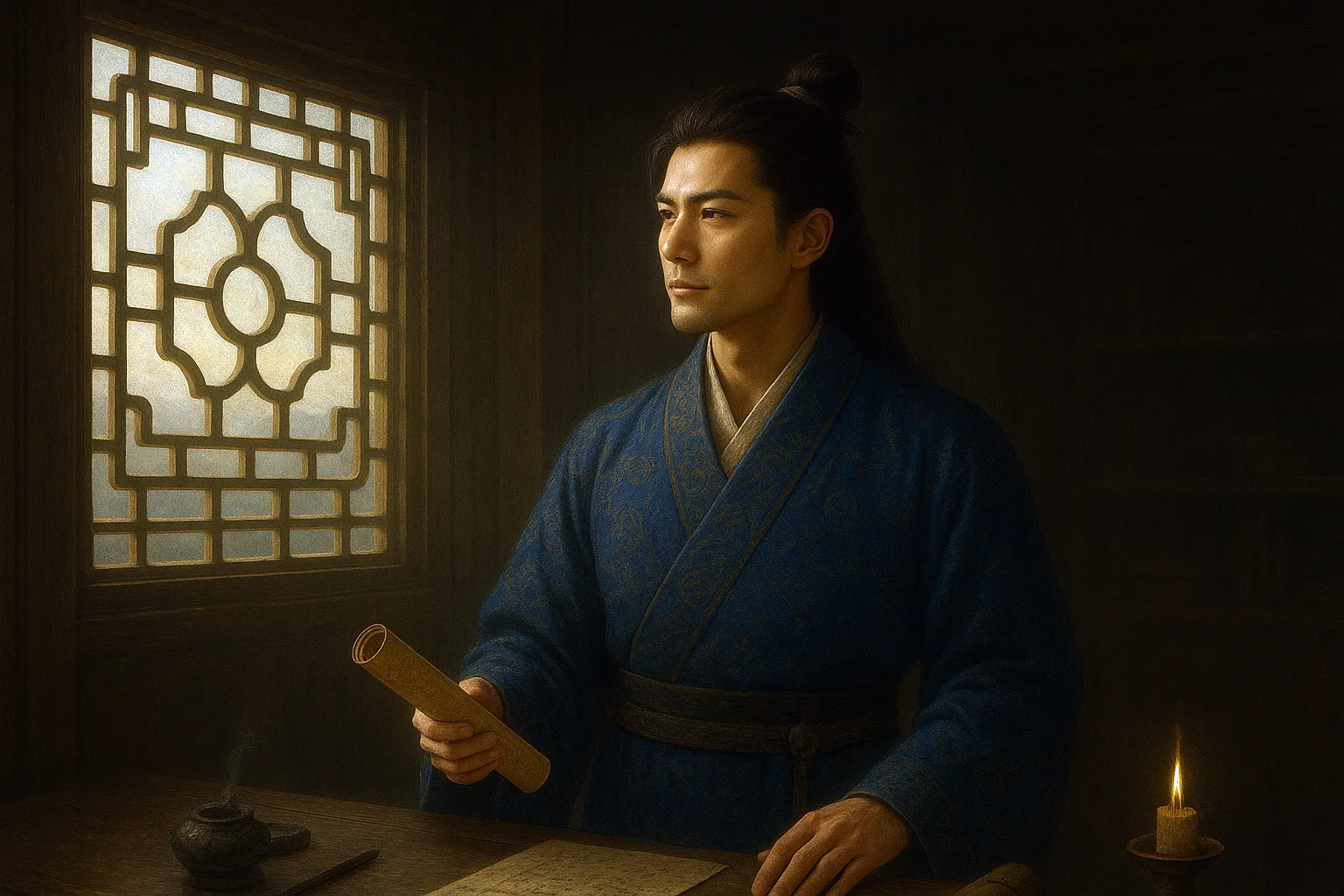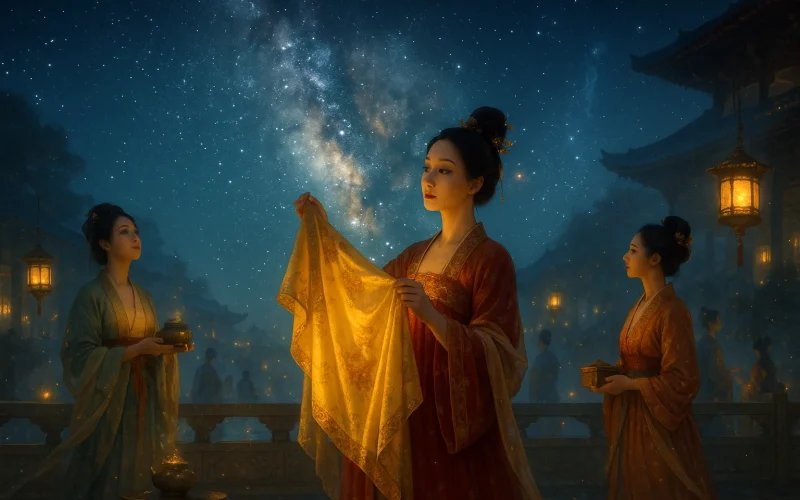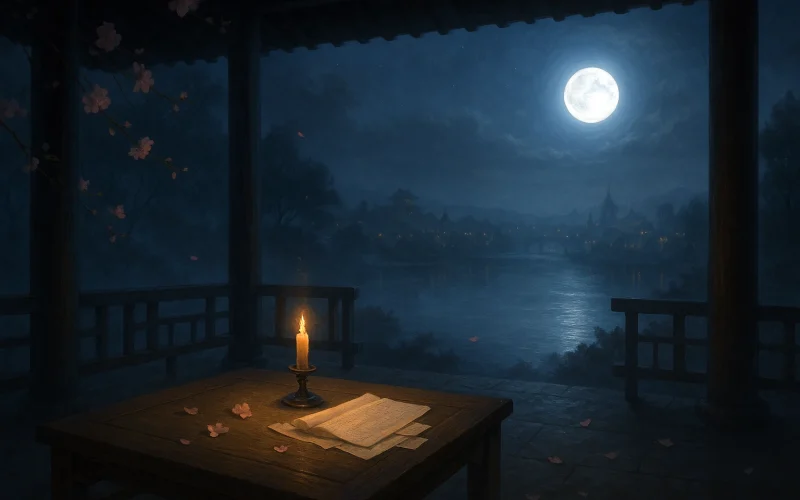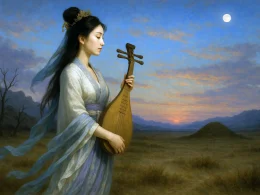The palace maids love the fair fragrant trees;
They cut out flowers rivalling flowers early to blow.
When cold is o’er, the use of scissors will cease;
When spring appears, their silken works will grow.
With tender stems their hair-like filaments roll;
Their scented pistils are made of silk white.
Their slender branches are happy in their role
To bend o’er the marble steps in the palace bright.
Original Poem
「剪彩」
沈佺期
宫女怜芳树,裁花竞早荣。
寒依刀尺尽,春向绮罗生。
弱蒂盘丝发,香蕤结素成。
纤枝幸不弃,长就玉阶倾。
Interpretation
This poem was written during Shen Quanqi's tenure in the capital, belonging to his early works on courtly themes. Tang dynasty palaces placed great emphasis on floral decorations, and each early spring, palace maidens would cut colorful silk flowers and adorn their robes to celebrate the season—a common scene in the courtly spring landscape. As a court poet, Shen Quanqi excelled at depicting palace scenes and figures with delicate brushstrokes, yet beneath the ornate language, he often embedded philosophical reflections on the impermanence of life and the cycle of prosperity and decline.
"The Cutting of Silk" superficially describes the maidens' playful act of adorning robes with flowers, but it is fundamentally a symbolic gesture of "cutting spring" and "cherishing spring." The tension between the bloom of flowers and their cutting隐喻 the paradox of beauty and transience, life and ornamentation—a hallmark of the introspective turn in Shen Quanqi's palace-style poetry.
First Couplet: "宫女怜芳树,裁花竞早荣。"
Gōngnǚ lián fāng shù, cái huā jìng zǎo róng.
Palace maidens cherish the fragrant trees,
Vying to cut blossoms for early splendor.
The opening line sets the tone with "cherish," conveying tenderness and a longing to preserve spring. Though the maidens act for decoration, their gesture implies a lament for the flowers' fleeting existence. This couplet pairs "fragrant trees" with "blossoms," creating spatial layers while embedding emotion in the scene, introducing the theme of "cutting silk."
Second Couplet: "寒依刀尺尽,春向绮罗生。"
Hán yī dāochǐ jìn, chūn xiàng qǐluó shēng.
The cold fades with the snip of scissors;
Spring emerges from the silken robes.
This couplet is highly symmetrical and symbolic. "Scissors," tools for cutting, symbolize the retreat of winter's chill; "silken robes," the maidens' attire, represent the rebirth of spring's vitality. Through contrast, "cold" and "spring," "blade" and "silk" form a clever visual and psychological shift, embodying the seasonal transition from stillness to flourish.
Third Couplet: "弱蒂盘丝发,香蕤结素成。"
Ruò dì pán sī fā, xiāng ruí jié sù chéng.
Delicate stems curl like silken threads;
Fragrant clusters form pristine knots.
This couplet showcases the poem's most exquisite imagery. Shen Quanqi's microscopic brushwork captures the flower's form in minute detail. "Delicate stems" emphasize fragility, while "curl like silken threads" depicts their soft intricacy, blending shape and sensation. The flower's scent and purity are rendered through metaphor, reflecting the refined beauty of palace poetry without descending into vulgarity.
Fourth Couplet: "纤枝幸不弃,长就玉阶倾。"
Xiān zhī xìng bù qì, zhǎng jiù yù jiē qīng.
The slender twigs, thankfully not discarded,
Lean long against the jade steps, cascading down.
The conclusion shifts from object to emotion. "Jade steps" symbolize the palace, while "cascading down" carries dual meaning: the honor of the flowers being cherished in the court, and the implied decline in "cascade," hinting at the irony of prosperity preceding fall. Shen Quanqi ends with lush imagery, using a subtle, somber closing to let a faint sorrow surface beneath the splendor.
Holistic Appreciation
Artistically, this work reflects Shen Quanqi's transition from "courtly ornamentation" to "introspective imagery." While seemingly depicting an elegant scene of maidens adorning robes, the poem meditates on the brevity of life and the fate of beauty. The cutting of flowers symbolizes both the honor of being adorned and the destiny of being controlled. The maidens' "cherishing of fragrant trees" is a lament for the flowers and a metaphor for their own fate—they too are "flowers" confined, decorated, and put on display.
The poem's structure is meticulously crafted:
- The first couplet introduces the theme and setting;
- The second couplet traces seasonal change, the return of vitality;
- The third couplet depicts the flower's form with delicate precision;
- The final couplet concludes symbolically, embedding emotion in the scene.
Its tonal patterns are strict, with natural parallelism, exemplifying the balance and fluency of the "Shen-Song style." The progression from "The cold fades with the snip of scissors" to "Spring emerges from the silken robes" mirrors a rhythmic shift from brevity to expansiveness, with the language itself mimicking seasonal and emotional change—a perfect fusion of sound and imagery.
Artistic Merits
- Elegant Precision, Harmonious Rhythm: Each couplet flows smoothly with rigorous parallelism, showcasing the maturity of early Tang regulated verse.
- Emotion Through Objects, Flowers as Human Metaphor: The fate of flowers mirrors the plight of palace maidens, alluding to the theme of beauty and sacrifice.
- Layered Imagery, Vivid Colors: "Fragrant trees," "silken robes," and "jade steps" form a resplendent spring tableau.
- Subtle Diction, Thought-Provoking Conclusion: "Thankfully not discarded" and "cascading down" surface calm but conceal pathos.
- Transitional Artistic Style: Blends the ornate style of the Six Dynasties with the precision of Tang regulated verse, marking the maturation of Shen Quanqi's poetic evolution.
Insights
Though depicting flowers, this work ultimately portrays people; though celebrating spring, it harbors sorrow. Beneath the luxurious language, Shen Quanqi imbues a philosophy of "splendor like flowers, prosperity inevitably fading." It reminds us: worldly favor and beauty are like cut blossoms—once glorious, yet destined to wither. The poem's insight lies in this—beauty lies not in duration, but in bloom; life's value lies not in length, but in inner fragrance. Using maidens and flowers as a mirror, Shen Quanqi reflects the cycle of rise and fall in human life, while his gentle brush writes the eternal Tang aesthetic of "radiance tinged with sorrow."
About the Poet

Shen Quanqi (沈佺期 c. 656–715), courtesy name Yunqing, was a native of Neihuang in Henan Province and an important poet of the early Tang Dynasty. Along with Song Zhiwen, he was renowned as one of the "Shen-Song" duo, whose work played a decisive role in finalizing the form of the five-character regulated verse (wuyan lüshi) in Tang poetry. His poems often include courtly compositions and travel-themed reflections, characterized by refined elegance and structural rigor. Shen was particularly skilled in the seven-character regulated verse (qilü), and his writing marks a transition from the lingering style of the Six Dynasties to the flourishing era of High Tang poetry. His contributions hold milestone significance in the development of modern-style verse (jintishi).












